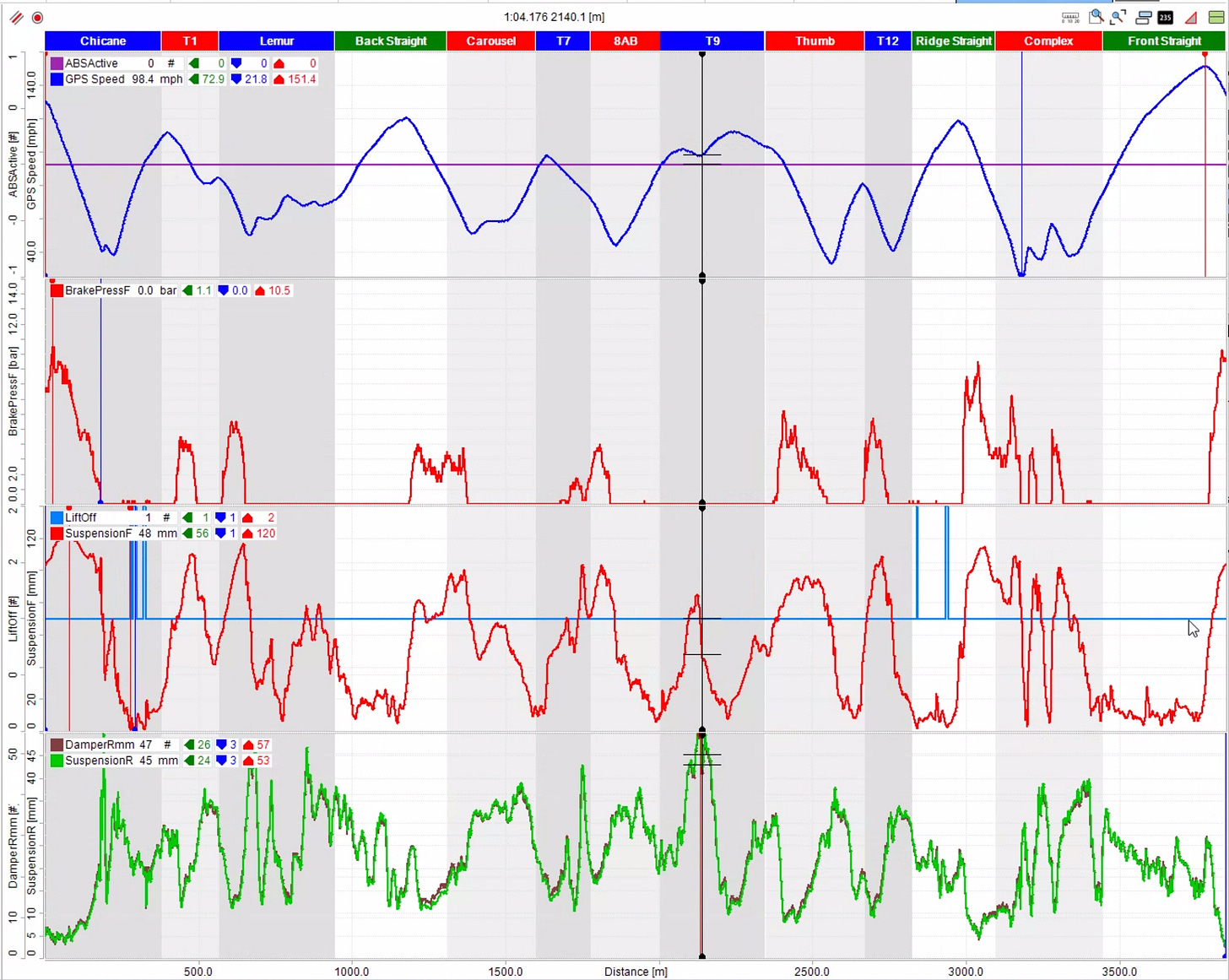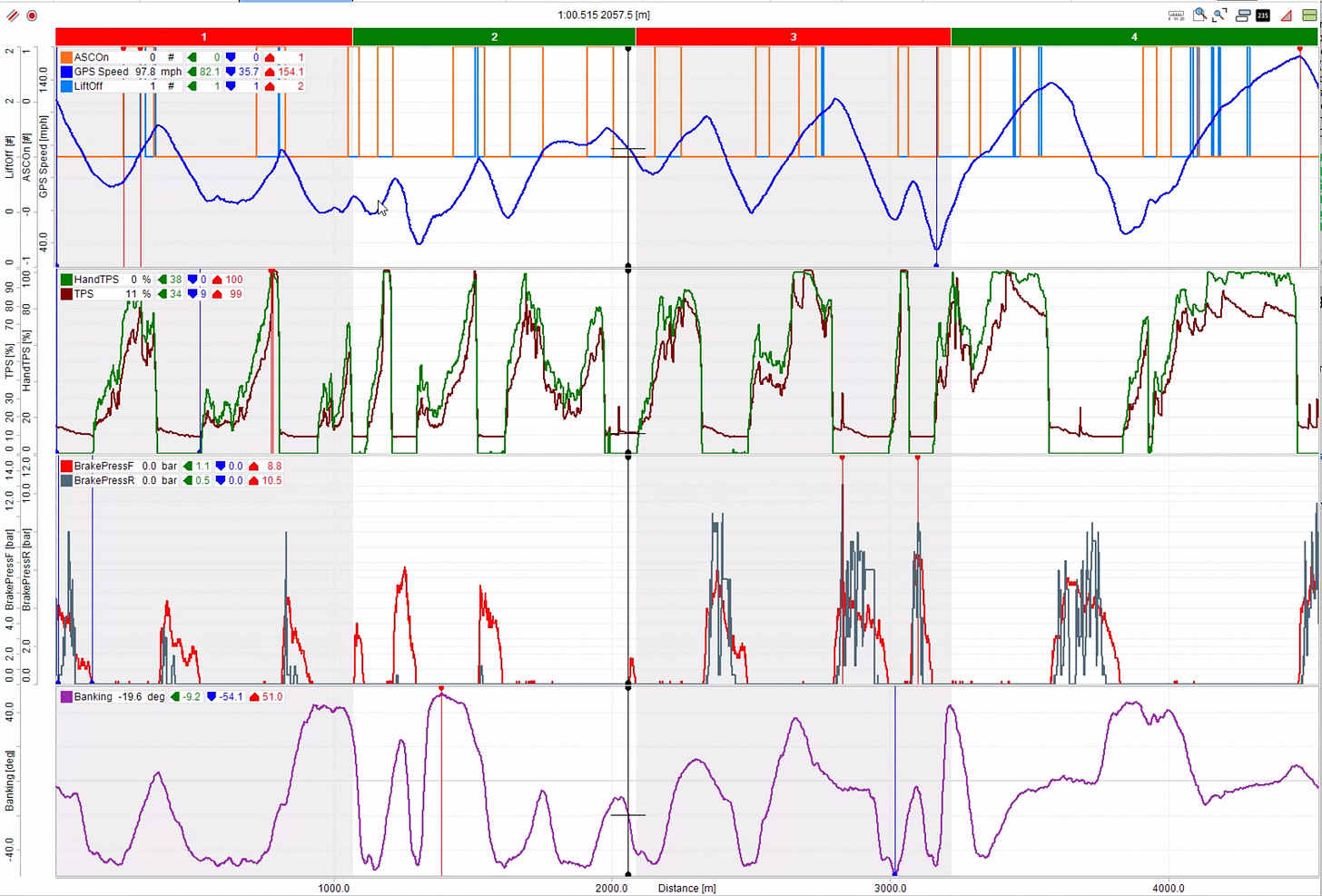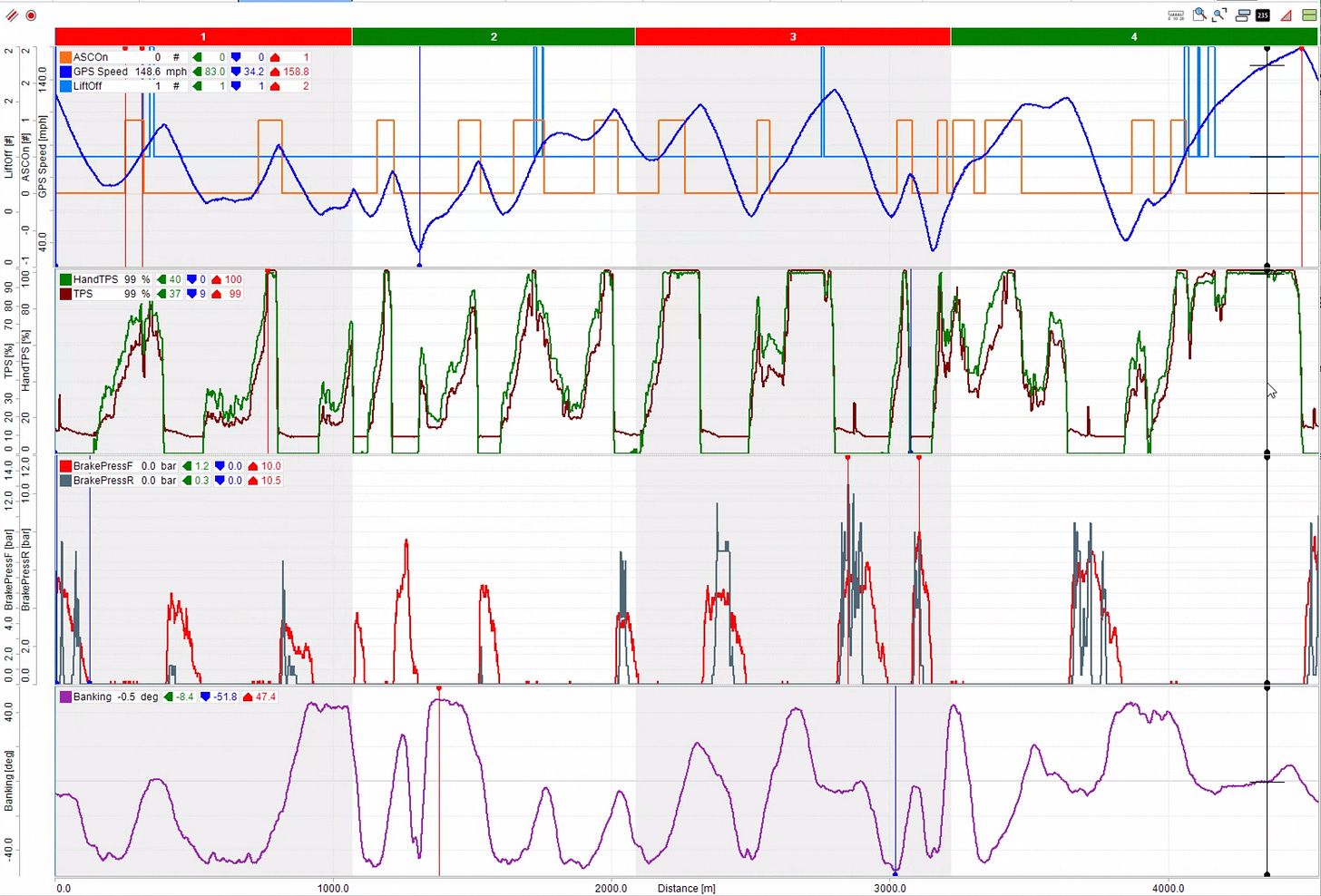BMW Data, Part 2
What I've learned about the BMW S1000RR (K67) now that I have some data
In Part 1, I detailed how I started getting data from the BMW, now we’ll cover what I’ve learned about the bike with that
As I mentioned in Part 1, data is huge for rider development, however it can also be incredibly useful in vehicle performance (and could be more important the higher up you go), and that’s what I’m focusing on in this series.
Suspension
Obviously, having suspension data really helps you get your suspension setup (way beyond putting a zip tie on a fork leg), and once it’s setup for you, you can see if you’re maximizing your ability to use the suspension properly (brake pressure at turn-in and front suspension travel, average and peak suspension travel, etc.).
Engine Tune
I was told by the previous owner of my BMW that the bike had a Bren Tune Stage 1 tune on it. In comparing hand throttle to butterflies, I was able to tell that on the front straight and the bike stood up, when my hand was at 100%, the butterflies were at ~80%. Not long after I took the bike to a tuner with a dyno and he found that the bike had the dealer-installed M-torque tune, not the Bren Tune flash. He remedied that with a custom flash built for my bike and I now see 100% (actually it peaks at 99%) on the butterflies when my hand is at 100% on the front straight (and the top speeds are higher). The new custom tune produces an even 200 bhp to the tire whereas the M-torque tune produced 177 bhp and it was not a smooth curve. The new tune from OpenFlash is more potent but the bike is easier to ride with it because the power is much more linear.
ABS
I retained the factory ABS on my bike as I have not found that to be a limiting factor. If you have the ABS on the bike, it gives you brake pressure data, separate for the front and rear. In the settings for the bike, there are ~5 different levels of ABS and I have it in the 2nd or 3rd least intrusive setting (which still allows the rear to lift and I personally like that as it’s become a ‘feel’ for me). With that, I discovered that the bike will automatically activate the rear brake in hard braking zones. It’s not enough that I can feel it, it’s just interesting to see that data channel light up when I know it wasn’t me.
Electronics/Nannies
Also interesting is to see how the ASC (automatic stability control) works. At moderate and greater lean angles, the bike will hold back the amount of power it produces (by reducing the butterfly opening) until the bike comes more upright. BMW’s documentation says it considers front vs rear wheel speed but I’ve not found the exact correlation yet. It *appears* that the bias is largely lean angle and throttle opening. When I have the +7/-7 TC at levels above +3, I can feel it more pronounced and the way that it releases the power when the bike becomes upright can sometimes be dramatic (enough for the front end to come up without provocation). If the conditions are good and the tire is fairly fresh, I’ll start at 0 or +1. If it’s a cold early session where I’ll start at +2 or +3 and I’ll do the same if the rear tire is appreciably worn and I’m feeling the rear slip noticeably. Above +3 and it feels much more dramatic to me in the way that it ‘releases’ the bike as you become vertical. I do want to experiment with much lower settings (say -5) to see if/how that impacts the ASC. Changing the overall TC profile in the Race Pro modes doesn’t seem to have much impact (at least in the more aggressive settings, I haven’t tried the road/rain settings). In the below set of graphs, the ASC is shown in the top graph overlaid with GPS speed. BTW, the ASC appears to correlate with the amber light in the top right of the dash lighting up, which is frequent.
Engine Health and Operating Conditions
Bikes usually don’t have a lot of data for engine health but most have coolant temperature, some may have oil temperature, maybe oxygen sensor, ignition advance, etc. At the very least, I’ll take a glance at coolant temperatures over the course of the day, just to make sure the temperatures aren’t getting too high. If I were building a race bike, I’d probably add oil temperature, maybe oil pressure, etc. The faster you go, the more of a consumable engines become but if you have a history of some of these measurements, you can get a sense of where you are in the health of the engine.

In RS3, I also have a page dedicated to suspension for the BMW. My bike’s integrated rear suspension pot tracks extremely closely to my AiM rear potentiometer, though the range is different by 2-4 mm. Rear suspension data in the last graph in the below set.

In the next set of graphs, near the front straight (toward the end of the graphs), notice in the 2nd graph where there are channels for HandTPS (hand throttle position) and TPS (butterflies). At one point, hand position is 100% but butterflies are at 74%. This is what drove my curiosity into the state of the tune since I was upright and ASC was not lit up.

Following the OpenFlash tune, you can see that the butterflies more closely match the hand position (assuming ASC is not engaged) in the 2nd graph. The 3rd graph shows front and rear brake pressure and I was only operating the front brake, the bike was activating the rear brake for me as part of the braking profile. As I mentioned before, I couldn’t feel the rear brake activating, nor could two test riders who are more proficient than I am. It would still be interesting to know the logic behind the algorithm for the rear brake activation.
Bike and Data Collection Wishlist
While I’m very happy with the BMW and the amount of data available from the stock ECU with the AiM hardware, there are a few things that are missing (both from BMW and AiM):
From BMW, there is no provision for the user to calibrate the wheel speeds. Ducati and Aprilia both have a calibration mode which allows you to roll through the pits when you change tire sizes which calibrates the TC/WC/ABS for a different tire size. On my Aprilia there is even a Tire Slip channel and if I change tire sizes and forget to calibrate, I’ll see some slip numbers that are off. One time I noticed it most with early ABS intervention. I wish BMW had an onboard facility for doing tire size calibration.
I have a spare set of wheels for my BMW and while the original wheels have TPMS sensors, I wish there was a way to code up the 2nd set of wheels for the TPMS. I was able to do this with my Triumph using a complete 3rd party set of i2M sensors and receiver. I had also implemented that data into the data stream so that my video overlay included tire pressure and wheel temperatures. My preferred BMW dash top display line is the tire pressure information. I find this particularly useful in case I’m held on grid for a few minutes as a reminder to get the tires warm before riding harder.
My BMW came with tire pressure sensors (I think the BMW abbreviation is RDS). I wish AiM had data channels for tire pressure and wheel temperature since both of those are measured by the TPMS sensors.
The AiM ECU profile logs the TC setting but I would really like for it to log the other user-configruable settings, including everything within RacePro modes (engine profile, ABS setting, wheelie control setting, traction control profile, etc.). It does record damper settings for bikes with the electronic suspension and the -7 to +7 DTC settings, as well as launch control.
The 24+ BMWs have a steering angle sensor as a part of the newer ‘slide control’ feature. Even though my bike pre-dates that feature, I would like to have that data channel in the AiM protocol in case I get a newer BMW.
Why doesn’t the BMW have a traditional Euro5 plug? Instead the only way to get data is via the BMW diagnostics plug. The bike also has a traditional ODBII plug however the AIM ODBII harness won’t work with that. Not a big deal as long as you know. Also note that the BMW diagnostics port has unswitched power so you’ll need to unplug your AiM hardware at the end of the day or you will drain your battery. I personally went with a flying leads harness and tapped into the CAN +/- and a switched power lead so that I don’t have to worry about leaving my data logger plugged in overnight but it’s a slightly more involved installation.
While I don’t expect anything to change on the BMW side with regard to allowing calibration or plug selection, I have worked extensively with AiM on different projects so if they can get their hands on a high-spec S1000RR, they can likely sniff the data to capture some of the other channels.
I still have more to discover with the electronics of the BMW and loads more of my own riding development but if you like to ride as well as geek out over data, this is a great platform and doesn’t take a lot to get data from it. This meshes well with my cautious nature in riding because I can look at data and find my own opportunities that aren’t too far outside my comfort zone and build on that.


